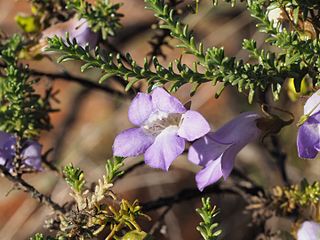
Eremophila denticulata, also known as toothed eremophila, toothed poverty bush and Fitzgerald eremophila, is a flowering plant in the figwort family, Scrophulariaceae and is endemic to the south-west of Western Australia. It is an erect shrub with red flowers and leaves that have toothed margins.

Eremophila maitlandii, commonly known as Shark Bay poverty bush, is a flowering plant in the figwort family, Scrophulariaceae and is endemic to Western Australia. It is a silvery-grey shrub with linear leaves and lilac-coloured to light purple flowers and is common in coastal areas between Shark Bay and Carnarvon.

Eremophila mackinlayi, commonly known as desert pride, is a flowering plant in the figwort family, Scrophulariaceae and is endemic to Western Australia. It is a shrub with its branches and leaves covered with a thick layer of yellow to grey hairs, mostly egg-shaped leaves and deep lilac-coloured to purple flowers. It is most closely related to E. strongylophylla and E. hygrophana and sometimes occurs in the same areas as these species.

Eremophila microtheca, also known as heath-like eremophila, is a flowering plant in the figwort family, Scrophulariaceae and is endemic to Western Australia. It is an erect shrub with densely hairy branches and leaves, narrow leaves and pale lilac-coloured flowers and which emits a strong odour.

Eremophila subfloccosa, also known as dense-felted eremophila is a plant in the figwort family, Scrophulariaceae and is endemic to Australia. It is a shrub which often has foliage covered with soft hairs, giving the plant a silvery grey hue and making it soft to touch. The leaves are strongly scented when crushed. Its flowers are usually greenish yellow in colour and have the stamens protruding from the ends. Dense-felted eremophila is common after fire, but becomes less so as others recover and compete with it.

Eremophila caerulea, commonly known as spotted eremophila, is a flowering plant in the figwort family, Scrophulariaceae and is endemic to the south-west of Western Australia. It is a low, compact, spreading shrub with narrow, warty, cylindrical leaves and blue to purple flowers.
Eremophila elderi, commonly known as aromatic emu bush, is a flowering plant in the figwort family, Scrophulariaceae. It is endemic to central Australia where it grows near the border between Western Australia, South Australia and the Northern Territory. It is an erect, aromatic shrub with sticky leaves and branches and usually pale coloured to white flowers. Its specific epithet (elderi) honours an early Australian businessman, Thomas Elder.

Eremophila exilifolia is a flowering plant in the figwort family, Scrophulariaceae and is endemic to Western Australia. It is a widely distributed shrub which is shaped like an inverted cone and has small, very sticky leaves and branches and lilac-coloured flowers.

Eremophila foliosissima, commonly known as poverty bush, is a flowering plant in the figwort family, Scrophulariaceae and is endemic to Western Australia. It is a small, erect, densely foliaged shrub with long, narrow, hairy leaves and mauve to purple flowers. It is similar to Eremophila gilesii but is more dense and rounded, has more crowded leaves and has different hairs on the flowers.

Eremophila gibbosa, commonly known as humped fuchsia bush, is a flowering plant in the figwort family, Scrophulariaceae and is endemic to Western Australia. It is a shrub with broad, shiny, sticky leaves and yellowish-green flowers and which often forms dense thickets.

Eremophila gilesii, commonly known Charleville turkey bush, green turkey bush, desert fuchsia and Giles emu bush is a flowering plant in the figwort family, Scrophulariaceae and is endemic to Australia. It is usually a low, spreading shrub with pinkish-lilac to purple flowers and is widespread in the Northern Territory and all mainland states except Victoria. It is considered a difficult agricultural weed in some parts of Queensland but is often used as a bush medicine by Aboriginal people.
Eremophila perglandulosa is a flowering plant in the figwort family, Scrophulariaceae and is endemic to Western Australia. It is a low, spreading shrub which has small leaves with many glandular hairs and mauve or purple flowers.
Eremophila petrophila is a flowering plant in the figwort family, Scrophulariaceae and is endemic to Western Australia. It is a tall, erect, open shrub with rough branches, narrow, sticky leaves and pale lilac-coloured flowers.
Eremophila phillipsii is a flowering plant in the figwort family, Scrophulariaceae and is endemic to Western Australia. It is a tall, erect, open shrub, with narrow leaves and lilac to purple flowers which are white with purple spots inside. It often has an offensive smell.

Eremophila pinnatifida, commonly known as Dalwallinu eremophila is a flowering plant in the figwort family, Scrophulariaceae and is endemic to Western Australia. It is a spreading, rounded shrub with aromatic, deeply divided leaves and pale purple flowers which are white with purple spots inside. It is a rare plant, known only from a few areas near Perth.

Eremophila sargentii is a flowering plant in the figwort family, Scrophulariaceae and is endemic to Western Australia. It is a shrub with sticky, shiny foliage, small leaves and mauve or blue flowers.
Eremophila shonae is a flowering plant in the figwort family, Scrophulariaceae and is endemic to Western Australia. It is an erect shrub or a low spreading shrub, depending on subspecies and has very sticky branches and leaves due to the presence of large amounts of resin. The leaves are narrow and the flowers are mauve to purple and white inside with purple spots.
Eremophila simulans is a flowering plant in the figwort family, Scrophulariaceae and is endemic to Western Australia. It is an erect shrub with broad, serrated leaves and violet to purple flowers.

Eremophila veneta, commonly known as metallic-flowered eremophila is a flowering plant in the figwort family, Scrophulariaceae and is endemic to Western Australia. It is a low, spreading, sticky shrub with dark green leaves and bluish-green petals.
Eremophila victoriae is small shrub with sessile, egg-shaped leaves and purple flowers and that is endemic to Western Australia. It is only known from two populations in the Great Victoria Desert.













